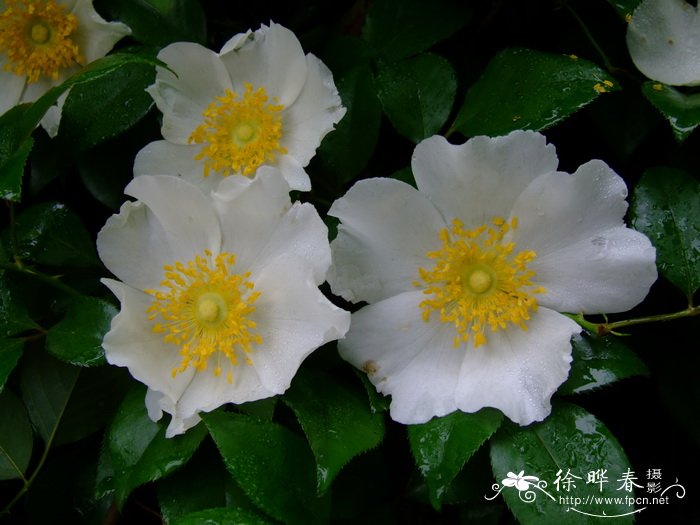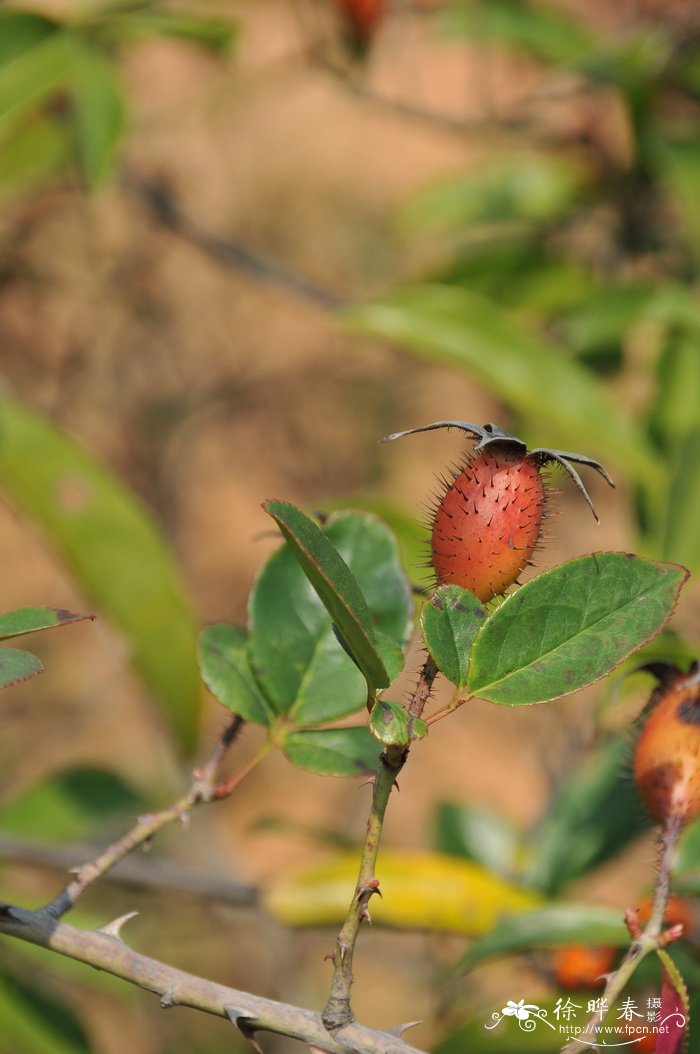金樱子Rosa laevigata
中文名(Chinese Name):金樱子
学名(Scientific Name):Rosa laevigata Michx.
英文名(English Common Name):Cherokee rose
别名(Chinese Common Name):山石榴、刺梨子
异名(Synonym):Rosa amygdalifolia Ser. Rosa argyi H. Lév. Rosa cucumerina Tratt. Rosa laevigata var. kaiscianensis Pamp. Rosa nivea DC. Rosa laevigata var. leiocarpa Y. Q. Wang et P. Y. Chen Rosa ternata Poir.
科属(Family & Genus):蔷薇科(Rosaceae)蔷薇属
形态特征(Description):常绿攀援灌木,高可达5米;小枝粗壮,散生扁弯皮刺,无毛,幼时被腺毛,老时逐渐脱落减少。小叶革质,通常3,稀5,连叶柄长5-10厘米;小叶片椭圆状卵形、倒卵形或披针状卵形,长2-6厘米,宽1.2-3.5厘米,先端急尖或圆钝,稀尾状渐尖,边缘有锐锯齿,上面亮绿色,无毛,下面黄绿色,幼时沿中肋有腺毛,老时逐渐脱落无毛;小叶柄和叶轴有皮刺和腺毛;托叶离生或基部与叶柄合生,披针形,边缘有细齿,齿尖有腺体,早落。花单生于叶腋,直径5-7厘米;花梗长1.8-2.5厘米,偶有3厘米者,花梗和萼筒密被腺毛,随果实成长变为针刺;萼片卵状披针形,先端呈叶状,边缘羽状浅裂或全缘,常有刺毛和腺毛,内面密被柔毛,比花瓣稍短;花瓣白色,宽倒卵形,先端微凹;雄蕊多数;心皮多数,花柱离生,有毛,比雄蕊短很多。果梨形、倒卵形,稀近球形,紫褐色,外面密被刺毛,果梗长约3厘米,萼片宿存。花期4-6月,果期7-11月。
分布(Distribution):产陕西、安徽、江西、江苏、浙江、湖北、湖南、广东、广西、台湾、福建、四川、云南、贵州等省区,喜生于海拔200-1600米向阳的山野、田边、溪畔灌木丛中。
用途(Use):根皮含鞣质可制栲胶,果实可熬糖及酿酒。根、叶、果均入药,根有活血散瘀、祛风除湿、解毒收敛及杀虫等功效;叶外用治疮疖、烧烫伤;果能止腹泻并对流感病毒有抑制作用。
引自中国植物志英文版:FOC Vol. 9 Page 380
Rosa laevigata Michaux, Fl. Bor.-Amer. 1: 295. 1803.
金樱子 jin ying zi| Rosaceae | Rosa
Rosa amygdalifolia Seringe; R. argyi H. Léveillé; R. cucumerina Trattinnick; R. laevigata var. kaiscianensis Pampanini; R. laevigata var. leiocarpa Y. Q. Wang & P. Y. Chen; R. nivea Candolle; R. ternata Poiret; R. triphylla Roxburgh.
Shrubs evergreen, climbing, to 5 m. Branchlets purple-brown, terete, robust; prickles scattered, curved, to 4 mm, flat, gradually tapering to a broad base; bristles glandular, dense on young stems, to 4 mm. Leaves including petiole 5–10 cm; stipules caducous, free or with base adnate to petiole, lanceolate, glandular serrate, apex acuminate; rachis and petiole shortly prickly and glandular bristly; leaflets 3, rarely 4, elliptic-ovate, obovate, or lanceolate-ovate, 2–6 × 1.2–3.5 cm, leathery, sometimes abaxially minutely prickly and glandular bristly along midvein when young, glabrescent, adaxially glabrous, base broadly cuneate, margin acutely serrate, apex acute or rounded-obtuse. Flower solitary, axillary, 5–10 cm in diam.; pedicel 1.8–2.5(–3) cm, densely glandular bristly; bracts absent. Hypanthium ovoid, densely glandular bristly. Sepals 5, persistent, slightly shorter than petals, ovate-lanceolate, leaflike, abaxially glabrous, adaxially densely pubescent, margin entire, often glandular bristly. Petals 5, semi-double, or double, white, broadly obovate, base broadly cuneate, apex emarginate. Styles free, much shorter than stamens, pubescent. Hip purple-brown, pyriform or obovoid, rarely subglobose, 0.8–1.5 cm in diam., densely glandular bristly, with persistent, erect sepals. Fl. Apr–Jun, fr. Jul–Nov.
Thickets, scrub, open montane areas, open fields, farmland; 200--1600 m. Anhui, Fujian, Guangdong, Guangxi, Guizhou, Hainan, Hubei, Hunan, Jiangsu, Jiangxi, S Shaanxi, Sichuan, Taiwan, Yunnan, Zhejiang [Vietnam; cultivated elsewhere].
Two forms may be recognized: f. laevigata, which has flowers single, 5–7 cm in diam., and f. semiplena T. T. Yü & T. C. Ku (Bull. Bot. Res., Harbin 1(4): 17. 1981), which has flowers semidouble, 5–10 cm in diam.
The root bark contains tannin, and is used for tanning. Sugar is extracted from the fruit, which is also used to ferment wine. The roots, leaves, and fruit are all used medicinally.




(责任编辑:徐晔春)
学名(Scientific Name):Rosa laevigata Michx.
英文名(English Common Name):Cherokee rose
别名(Chinese Common Name):山石榴、刺梨子
异名(Synonym):Rosa amygdalifolia Ser. Rosa argyi H. Lév. Rosa cucumerina Tratt. Rosa laevigata var. kaiscianensis Pamp. Rosa nivea DC. Rosa laevigata var. leiocarpa Y. Q. Wang et P. Y. Chen Rosa ternata Poir.
科属(Family & Genus):蔷薇科(Rosaceae)蔷薇属
形态特征(Description):常绿攀援灌木,高可达5米;小枝粗壮,散生扁弯皮刺,无毛,幼时被腺毛,老时逐渐脱落减少。小叶革质,通常3,稀5,连叶柄长5-10厘米;小叶片椭圆状卵形、倒卵形或披针状卵形,长2-6厘米,宽1.2-3.5厘米,先端急尖或圆钝,稀尾状渐尖,边缘有锐锯齿,上面亮绿色,无毛,下面黄绿色,幼时沿中肋有腺毛,老时逐渐脱落无毛;小叶柄和叶轴有皮刺和腺毛;托叶离生或基部与叶柄合生,披针形,边缘有细齿,齿尖有腺体,早落。花单生于叶腋,直径5-7厘米;花梗长1.8-2.5厘米,偶有3厘米者,花梗和萼筒密被腺毛,随果实成长变为针刺;萼片卵状披针形,先端呈叶状,边缘羽状浅裂或全缘,常有刺毛和腺毛,内面密被柔毛,比花瓣稍短;花瓣白色,宽倒卵形,先端微凹;雄蕊多数;心皮多数,花柱离生,有毛,比雄蕊短很多。果梨形、倒卵形,稀近球形,紫褐色,外面密被刺毛,果梗长约3厘米,萼片宿存。花期4-6月,果期7-11月。
分布(Distribution):产陕西、安徽、江西、江苏、浙江、湖北、湖南、广东、广西、台湾、福建、四川、云南、贵州等省区,喜生于海拔200-1600米向阳的山野、田边、溪畔灌木丛中。
用途(Use):根皮含鞣质可制栲胶,果实可熬糖及酿酒。根、叶、果均入药,根有活血散瘀、祛风除湿、解毒收敛及杀虫等功效;叶外用治疮疖、烧烫伤;果能止腹泻并对流感病毒有抑制作用。
引自中国植物志英文版:FOC Vol. 9 Page 380
Rosa laevigata Michaux, Fl. Bor.-Amer. 1: 295. 1803.
金樱子 jin ying zi| Rosaceae | Rosa
Rosa amygdalifolia Seringe; R. argyi H. Léveillé; R. cucumerina Trattinnick; R. laevigata var. kaiscianensis Pampanini; R. laevigata var. leiocarpa Y. Q. Wang & P. Y. Chen; R. nivea Candolle; R. ternata Poiret; R. triphylla Roxburgh.
Shrubs evergreen, climbing, to 5 m. Branchlets purple-brown, terete, robust; prickles scattered, curved, to 4 mm, flat, gradually tapering to a broad base; bristles glandular, dense on young stems, to 4 mm. Leaves including petiole 5–10 cm; stipules caducous, free or with base adnate to petiole, lanceolate, glandular serrate, apex acuminate; rachis and petiole shortly prickly and glandular bristly; leaflets 3, rarely 4, elliptic-ovate, obovate, or lanceolate-ovate, 2–6 × 1.2–3.5 cm, leathery, sometimes abaxially minutely prickly and glandular bristly along midvein when young, glabrescent, adaxially glabrous, base broadly cuneate, margin acutely serrate, apex acute or rounded-obtuse. Flower solitary, axillary, 5–10 cm in diam.; pedicel 1.8–2.5(–3) cm, densely glandular bristly; bracts absent. Hypanthium ovoid, densely glandular bristly. Sepals 5, persistent, slightly shorter than petals, ovate-lanceolate, leaflike, abaxially glabrous, adaxially densely pubescent, margin entire, often glandular bristly. Petals 5, semi-double, or double, white, broadly obovate, base broadly cuneate, apex emarginate. Styles free, much shorter than stamens, pubescent. Hip purple-brown, pyriform or obovoid, rarely subglobose, 0.8–1.5 cm in diam., densely glandular bristly, with persistent, erect sepals. Fl. Apr–Jun, fr. Jul–Nov.
Thickets, scrub, open montane areas, open fields, farmland; 200--1600 m. Anhui, Fujian, Guangdong, Guangxi, Guizhou, Hainan, Hubei, Hunan, Jiangsu, Jiangxi, S Shaanxi, Sichuan, Taiwan, Yunnan, Zhejiang [Vietnam; cultivated elsewhere].
Two forms may be recognized: f. laevigata, which has flowers single, 5–7 cm in diam., and f. semiplena T. T. Yü & T. C. Ku (Bull. Bot. Res., Harbin 1(4): 17. 1981), which has flowers semidouble, 5–10 cm in diam.
The root bark contains tannin, and is used for tanning. Sugar is extracted from the fruit, which is also used to ferment wine. The roots, leaves, and fruit are all used medicinally.
(责任编辑:徐晔春)
踩一下[0]

顶一下[2]